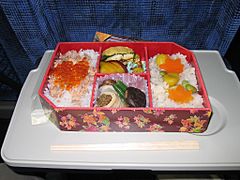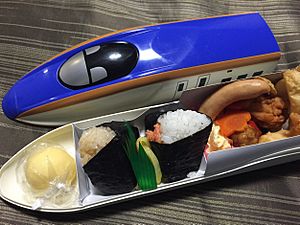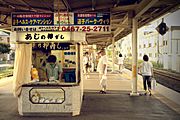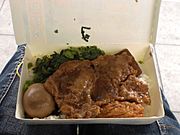Ekiben facts for kids

A typical 1000-yen ekiben from Tokyo Station
|
|
| Type | Boxed meal |
|---|---|
| Associated national cuisine | Japan |
Ekiben (駅弁, railway bento) are a special kind of bento (which are boxed meals) you can buy on trains and at train stations in Japan. They usually come with disposable chopsticks or spoons. Ekiben containers can be made from plastic, wood, or even ceramic! Many train stations are famous for their ekiben that use special local foods from that area.
Ekiben were first sold in the late 1800s. Back then, train journeys were very long, so people needed meals on the train. Ekiben were super popular in the 1980s! But then, air travel became cheaper, and trains became much faster. This meant fewer people needed meals during their shorter trips.
Even though their popularity changed, you can still buy many different kinds of ekiben. You'll find them at stands in the station, on the platform, or right on the train. Some ekiben come in cool, unique containers that you can keep as souvenirs! Ekiben are still a favorite among travelers, especially on the Shinkansen (Japan's bullet trains). This is because dining car services on trains stopped in the 1990s.
Ekiben-style meals are also popular in other parts of East Asia, like Taiwan. They have their own version called the Taiwan Railway Mealbox.
Contents
What is Ekiben?
The word ekiben comes from two Japanese words: "eki", which means railway station, and "ben", which is short for bento (box meal). So, ekiben literally means "station meal in a box."
Before trains, travelers would bring their own food or buy meals from tea houses. These meals were often in wooden bento boxes. There were also "between-acts box lunches" called makunouchi-bento sold during kabuki theater shows. These old box lunches helped inspire the ekiben we know today.
The History of Ekiben
The first ekiben is thought to have been sold at Utsunomiya Station in 1885. This station opened when a train line connected it to Ueno Station in Tokyo. At first, ekiben were very simple. The ones at Utsunomiya Station were just onigiri (rice balls) wrapped in young bamboo leaves.
The idea of selling ekiben quickly spread across Japan. By 1888, the first standard ekiben with rice and a few side dishes were sold at Himeji Station.
Ekiben and Local Specialties
In the early 1900s, many stations started offering ekiben made with special local foods. This made ekiben unique from other bento boxes. These special meals are often found only at the local railway stations where they are made.
A famous example is ikameshi, which is squid stuffed with rice. It's sold at Mori Station in Hokkaido. Ikameshi started as an ekiben meal but became a well-known local dish. Many ekiben today are sold as souvenirs for tourists, with cool containers and attractive packaging.

The Golden Age and Changes
Train travel in Japan became very popular after World War II. The popularity of ekiben grew even more in the 1970s because of a popular story about someone who traveled around Japan just to try different ekiben. In the mid-1980s, during the "Golden Age" of ekiben, it's estimated that twelve million boxes were eaten every day!
However, this "Golden Age" ended in the 1980s. Air travel became cheaper, and faster trains like the Shinkansen became more common. These faster trains also skipped many stops, which meant fewer chances to buy ekiben. Because of this, the number of ekiben makers dropped by 50% between 1987 and 2008.
But ekiben found new life! When dining cars on trains stopped in the 1990s, ekiben became popular again, especially on the Shinkansen. They also remain popular on slower, cheaper commuter trains.
Today, you can even find ekiben outside of train stations, like in department stores and airports. Big ekiben fairs are held every year at department stores, where you can try many different kinds. The biggest ones are at the Keio Department Store in Shinjuku Station, Tokyo, and Hanshin Department Store in Osaka.
Types of Ekiben
There are many different kinds of ekiben to choose from! The most common type found across Japan is called makunouchi-bento. This usually has rice, grilled fish, fish cakes, pickles, and other classic items.
You can also find regional ekiben that use local ingredients and cooking styles. For example, masuzushi is an ekiben from Toyama Prefecture. It features trout oshizushi (pressed sushi) wrapped in bamboo leaves. Each region offers a unique taste experience!
Gallery
-
Sukiyaki bento sold at Yonezawa Station, with heating capabilities.
See also
 In Spanish: Ekiben para niños
In Spanish: Ekiben para niños







